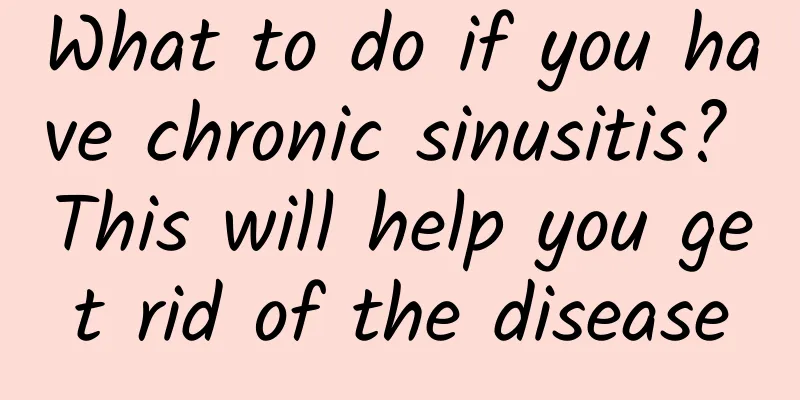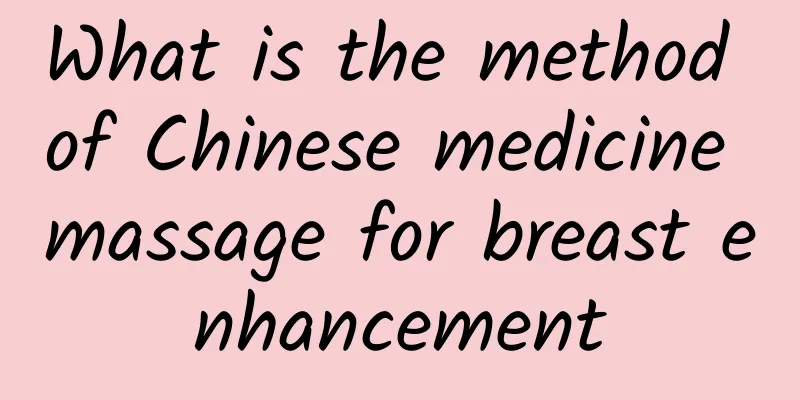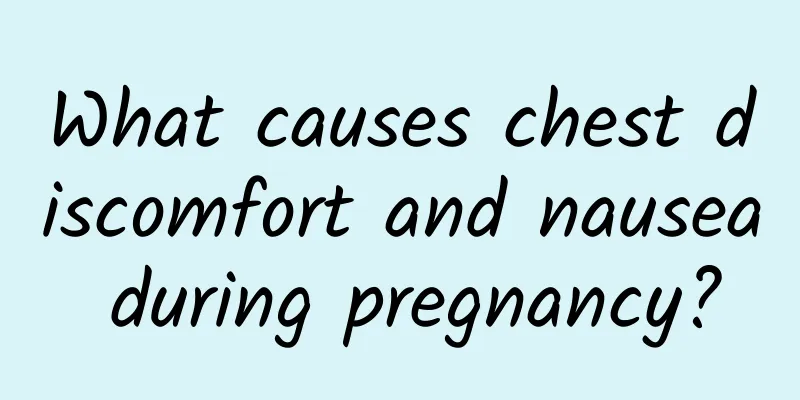What to do if you have chronic sinusitis? This will help you get rid of the disease

|
Chronic sinusitis is inflammation of the sinuses. Chronic sinusitis is a common disease in the nose, usually caused by the late stage of acute sinusitis. What should patients with this disease do? What are some ways to get rid of illness? 1. Acute sinusitis It is mostly due to improper treatment of acute sinusitis, or failure to treat it thoroughly, resulting in repeated attacks and prolonged illness, turning it into a chronic disease. This is the primary cause of this disease. 2. Obstructive causes Obstructive diseases in the nasal cavity, such as nasal polyps, hypertrophy of nasal conchae, nasal stones, deviated nasal septum, nasal tumors, nasal packing, etc., which hinder the ventilation and drainage of the nasal cavity and sinuses, are the important causes of this disease. 3. Pathogenic bacteria are highly toxic Acute sinusitis caused by certain highly virulent pathogens, such as beta-hemolytic streptococci during scarlet fever, can easily turn into chronic sinusitis. 4. Odontogenic infection Because the roots of the upper molars are adjacent to the bottom of the maxillary sinus, if the dental disease is not cured, it can easily develop into odontogenic chronic maxillary sinusitis. 5. Trauma and foreign bodies Chronic sinusitis may be caused by traumatic fractures, retained foreign bodies or blood clot infection. 6. Sinus anatomy The special or abnormal anatomical structure of each sinus is not conducive to ventilation and drainage, which is also an intrinsic factor that cannot be ignored. 7. Systemic factors This includes low body resistance caused by various chronic diseases, malnutrition, and excessive fatigue. At the same time, there are various allergic factors and causes induced by bronchiectasis. Clinical manifestations 1. Prone groups It is prone to occur in all groups, but is more common in the young, elderly and weak. 2. Disease symptoms (1) Local symptoms ① Purulent nasal discharge: The nasal discharge is mostly purulent or mucopurulent, yellow or yellow-green in color, with variable amounts, and can flow back into the pharynx. If there is a foul odor on one side, it is often seen in odontogenic maxillary sinusitis or fungal infection. ②Nasal congestion: varies in severity, mostly caused by congestion and swelling of the nasal mucosa and increased secretions. ③ Olfactory impairment: Nasal congestion and inflammatory response can lead to olfactory impairment. ④Headache: Chronic sinusitis generally does not cause obvious local pain or headache. If you have a headache, it is often a dull pain or a feeling of heaviness in the head that is worse during the day and less severe at night. The former group of sinusitis often presents with swelling or dull pain in the forehead and root of the nose, while the latter group of sinusitis often presents with headaches at the top of the head and the back of the head. When suffering from odontogenic maxillary sinusitis, it is often accompanied by pain in the upper teeth on the same side. ⑤Others: Due to the flow of purulent mucus into the pharynx and long-term mouth breathing, it is often accompanied by symptoms of chronic pharyngitis, such as excessive sputum, foreign body sensation or dry and painful throat. If the Eustachian tube is affected, symptoms such as tinnitus and deafness may also occur. (2) Other symptoms include a feeling of pressure in the eyes, which may also cause visual impairment, but this is rare. A feeling of heaviness or pressure in the head, or just dull or muffled pain. (3) Systemic symptoms are mild or not obvious, and may include dizziness, fatigue, depression, malaise, poor appetite, insomnia, memory loss, lack of concentration, and reduced work efficiency. In very rare cases, if the lesion has already developed, there may be persistent low-grade fever. 3. Disease hazards It affects the patient's quality of life and aggravates the patient's respiratory infection symptoms. In severe cases, it may cause cranial, ocular and pulmonary complications, leading to vision changes and even worsening of the infection and death. examine 1. Nasal examination The lesions are mainly in the upper part of the nasal cavity, with edema or hypertrophy of the middle turbinate and even polypoid changes. Multiple polyps may be seen in some cases. In the anterior group of sinusitis, mucopurulent secretions can be seen attached to the surface of the middle nasal meatus and inferior turbinate, while in the posterior group of sinusitis, mucopurulent secretions can be seen in the olfactory fissure and the posterior part of the middle nasal meatus. In severe cases, purulent secretions can be seen in the nasopharynx. 2. Auxiliary examination (1) Nasal endoscopic examination is an examination of the anterior and posterior nasal cavity. Ephedrine is used to shrink the nasal mucosa, and then all parts of the nasal cavity are carefully examined. Edema, purulent discharge, or polyps may be seen. (2) Postural drainage: When chronic sinusitis is suspected and there is no pus in the middle nasal meatus or olfactory fissure, postural drainage examination can be performed. (3) Maxillary sinus puncture and irrigation Maxillary sinus puncture and irrigation is both a diagnostic method and a treatment measure for maxillary sinusitis. The flushing fluid should be used for aerobic bacterial culture and drug sensitivity testing. (4) X-ray sinusography can assist in diagnosis when the diagnosis is unclear or other lesions are suspected. (5) Dental examination: When odontogenic maxillary sinusitis is suspected, a specialist dental examination should be performed. (6) Sinus CT diagnosis Sinus CT helps to clarify the scope of the lesion, helps to clarify the local bone changes, and helps to differentiate it from nasal tumors. Due to its high resolution, CT can observe lesions in a more detailed and comprehensive manner and is currently a good indicator for diagnosing chronic sinusitis. (7) Sinus MRI MRI has a good degree of differentiation between soft tissue and fluid in the sinuses and is helpful for formulating a complete surgical plan before surgery. diagnosis The diagnosis can be made based on the cause, typical symptoms and related examinations. Differential Diagnosis It is mainly differentiated from other diseases that cause headaches, such as migraine and intracranial tumors; due to nasal congestion, it is necessary to differentiate from nasal sinus tumors, such as intranasal refractory papilloma, nasal squamous cell carcinoma, etc., which can be made clear by pathological diagnosis. complication treat 1. Antibiotics Although macrolide antibiotics cannot eliminate bacteria, they can reduce the toxicity of chronic bacterial infections and reduce cell damage. In cases where hormonal therapy fails, selective long-term low-dose macrolide antibiotic therapy is effective. The specific mechanism of action is not very clear, but it may be related to the downregulation of local host immune response and the weak toxicity of the propagated bacteria. 2. Vasoconstrictors It can shrink the swollen mucosa of the nasal cavity to facilitate sinus drainage. However, vasoconstrictors should not be used for a long time as they may cause secondary drug-induced rhinitis. 3. Mucus promoter Adding mucus promoters to standard treatment methods can achieve better treatment effects, mainly by reducing treatment time. 4. Antihistamines Although antihistamines are not recommended for the treatment of chronic rhinosinusitis, a study in the United States showed that antihistamines are often used in the treatment of chronic rhinosinusitis and can significantly relieve symptoms of sneezing, runny nose and nasal congestion, but have no significant effect on the size of nasal polyps. 5. Hypertonic saline Hypertonic saline can improve the nasal mucociliary clearance rate. Clinical trial results show that hypertonic saline has obvious effects on various evaluation indicators of cough, runny nose, and postnasal drip syndrome. 6. Physical therapy Ultrashort wave diathermy is generally used as an auxiliary treatment. 7. Sinus replacement Sinus replacement. Suitable for multiple sinus infections and children. 8. Surgery (1) Endoscopic sinus surgery is currently the preferred method. Under the clear vision of nasal endoscope, all sinus lesions are completely removed, the sinus ostia are fully opened, sinus drainage is improved, and normal tissue is preserved as much as possible. It is a minimally invasive surgery that preserves function as much as possible. (2) Other surgeries include maxillary sinus fenestration, maxillary sinus radical resection, intranasal ethmoid sinus resection, external ethmoid sinus resection, frontal sinus drilling, frontal sinus incision, sphenoid sinus incision, etc. For a patient diagnosed with chronic sinusitis, the recommended treatment procedure should be: first, drug treatment (including local and systemic application), and then perform sinus CT scan if drug treatment is ineffective. If there are imaging changes and surgical indications, then perform endoscopic sinus surgery. Prognosis Most patients can be cured with medication and surgical treatment. However, for a small number of patients with special physical conditions such as allergies, asthma, aspirin intolerance, etc., the disease often recurs. prevention 1. Strengthen physical exercise, improve physical fitness and prevent colds. 2. Acute rhinitis (colds) and dental diseases should be treated actively. 3. Do not blow your nose hard when there is secretion in the nasal cavity. You should block one nostril and blow out the nasal secretions, then block the other nostril and blow out the nasal secretions. 4. Timely and thorough treatment of acute nasal inflammation and correction of nasal anatomical deformities, as well as treatment of chronic rhinitis and nasal septum deviation. 5. Avoid diving and choking when swimming. 6. It is not advisable to fly when suffering from acute rhinitis. 7. Properly treat allergic diseases and improve nasal and sinus ventilation and drainage. |
<<: What causes acute laryngitis? How can we effectively prevent it?
>>: What causes pharyngitis cough and how to say goodbye to pharyngitis?
Recommend
How to store fresh ginseng
Now that people's living standards have impro...
My hands are always hot. What's the best way to relieve it?
First of all, fever is one of the problems we wil...
Does the Kowloon worm have an aphrodisiac effect?
In daily life, most women dislike insects, but th...
What to do if the bellyband is around the neck
After a woman becomes pregnant, she will go to th...
Causes of long-term red bloodshot eyes
If your eyes often have red bloodshot eyes, it ma...
Can fragrant tea cure bad breath?
Fragrant and refreshing tea is a kind of tea made...
What Chinese patent medicine should I take for triple-burner damp-heat?
When there is dampness in the body, there will be...
How does calcified epithelioma come about?
Xiao Zhang has been very unhappy recently because...
Can papaya and kudzu root compressed candy help enlarge breasts?
For women, breast enhancement is always a topic o...
Pseudoephedrine hydrochloride
Maybe many people don’t know much about pseudoeph...
What are the effects and functions of dried earthworms?
Dried earthworm is a traditional Chinese medicine...
Can I eat biscuits if I have gastric ulcer? Pay attention to your diet for better results
Patients with gastric ulcers should eat easily di...
What are the symptoms of mild depression?
If you put too much pressure on yourself in your ...
Is it effective to treat cervical spondylosis by tilting your head back?
Cervical spondylosis is a common disease in daily...
What is genital warts?
When it comes to genital warts, I think most peop...









